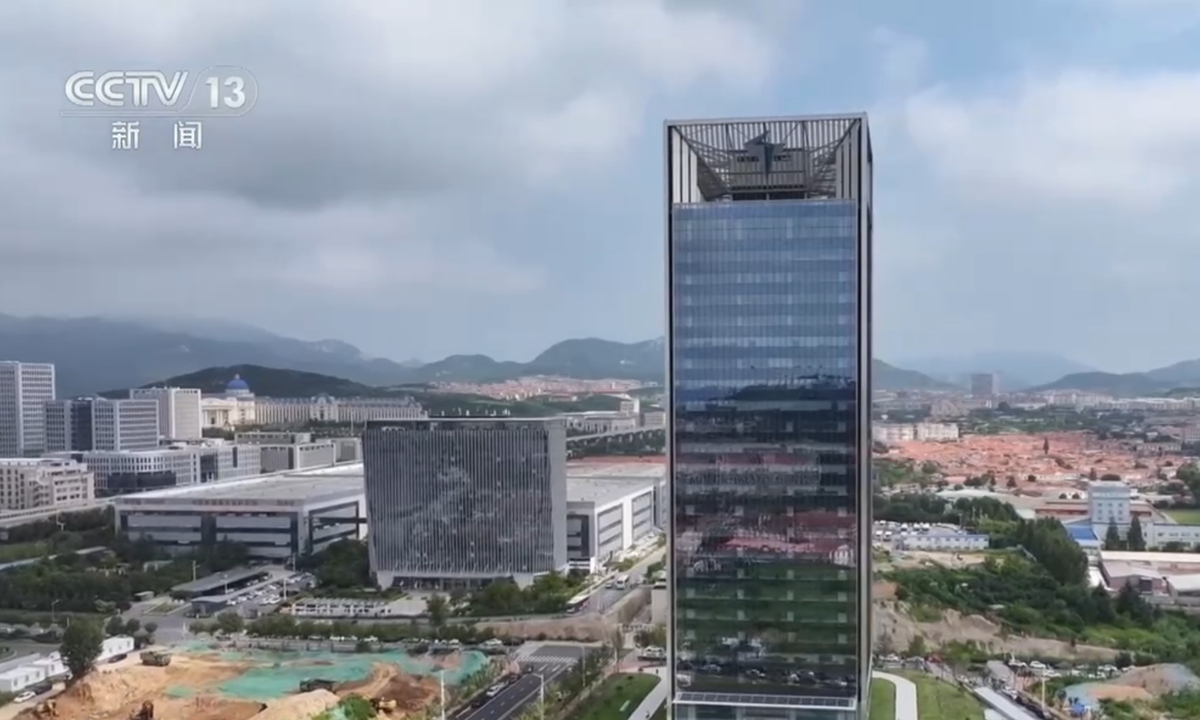A view of the world’s first ultra-tier zero-carbon building in Qingdao, East China’s Shandong Province on August 24, 2025. Photo: Screenshot of CMG’s vedio
The world’s first ultra-tier zero-carbon building was inaugurated in Qingdao, East China’s Shandong Province on Sunday, marking new progress in China’s zero-carbon architectural innovation. In addition to photovoltaic (PV) power generation, the building is also able to discharge power through recycled batteries and new-energy vehicles, CCTV News reported.
The building is 117 meters tall and has 23 office floors that consume about 6,000 kilowatt-hours of electricity. Unlike traditional rooftop PV systems, three sides of the building have been equipped with building-integrated photovoltaic glass curtain walls, which provide about 25 percent of green energy to the building and reduce carbon emissions by about 500 tons a year, according to the report.
At its base, 14 recycled automotive batteries serve as a “hidden energy reservoir.” Through charging and discharging, these batteries not only store surplus PV energy but also store clean energy that couldn’t be consumed in the grid at rates as low as 0.22 yuan ($0.03) per kilowatt-hour for use during peak demand or on cloudy days, it said.
A digital ecosystem underpins the building’s operations, integrating traditional substations, distribution stations, and other critical infrastructure into a unified system to achieve 100 percent green energy self-sufficiency.
Nearly 24,000 micro-sensors have replaced conventional switches, enabling automated control of lighting, air conditioners, and elevators. For instance, with facial recognition, the system can instantly detect a person’s destination floor and immediately dispatch the nearest available elevator, according to the report.
“Through the consumption of green power, we can reduce carbon emissions by approximately 2,500 tons annually. Digitalization has significantly lowered the building’s investment costs by 20-30 percent, improved operational efficiency by 30 percent, and reduced energy consumption costs by roughly 30 percent,” said Yu Dexiang, chairman of Teld New Energy.
Zhao Yue, director of the Energy Conservation and Green Energy Research Office of the China Center for Information Industry Development, said that the ultra-tier zero-carbon building is not only a structure but also a complete energy ecosystem.
“It has achieved 100 percent self-sufficiency in green power, established a new model for zero-carbon buildings, addressed the recycling challenges of power batteries, and through standardized centralized management, it has mitigated the environmental risks linked to decentralized battery disposal,” Zhao said.
China’s green transition continued to drive the development of renewable energy, which accounted for 91.5 percent of its total newly installed power capacity in the first half of 2025, according to data released by the National Energy Administration on July 31.
As of the end of June, the cumulative installed capacity of the country’s renewable energy reached 2.16 billion kilowatts, up 30.6 percent year-on-year and representing 59.2 percent of the country’s total installed power capacity, the data showed.
Global Times
